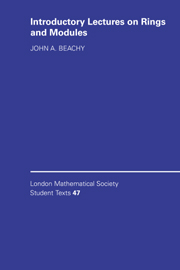3 - STRUCTURE OF NONCOMMUTATIVE RINGS
Published online by Cambridge University Press: 05 June 2012
Summary
If we use the standard identification of the complex number a + bi. with the ordered pair (a, b) in the Euclidean plane R2, then multiplication in C allows us to multiply ordered pairs. This multiplication respects the structure of R2 as a vector space over R, where r(a, b) = (ra, rb) for r ∈ R, since if x = (a, b) and y = (c, d), then r(xy) = (rx)y = x(ry). Hamilton discovered the quaternions H (recall Example 1.1.6) in 1843 after all of his efforts to find such a multiplication on R3 ended in failure. He finally realized that it was necessary to work in R4 and that he had to drop the requirement of commutativity. In our current terminology, Hamilton had found the most elementary example of a division ring. (Recall Definition 1.1.6: a division ring satisfies all of the axioms of a field, with the possible exception of the commutative law for multiplication.) We note that Wedderburn showed in 1909 that it is impossible to give a finite example of a division ring that is not a field.
An algebra over a field F is a ring A that is also a vector space over F, in which c(xy) = (cx)y = x(cy) for all x, y ∈ A and c ∈ F. The algebra A is called finite dimensional if A is a finite dimensional vector space over F, and it is called a division algebra if it is a division ring. (Refer to Definition 1.5.7.)
Information
- Type
- Chapter
- Information
- Introductory Lectures on Rings and Modules , pp. 137 - 170Publisher: Cambridge University PressPrint publication year: 1999
